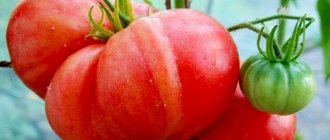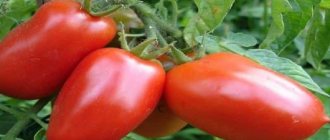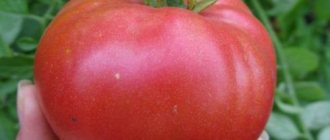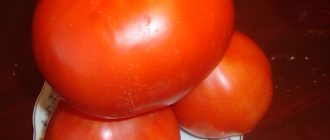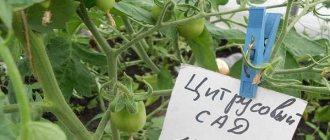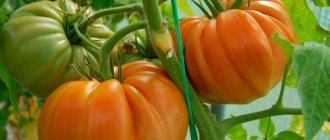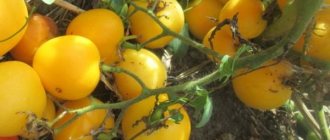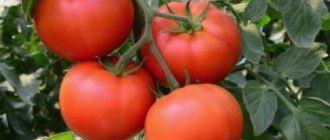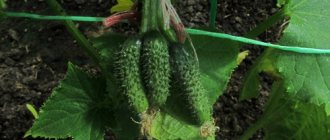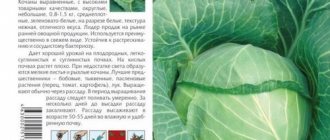The strength of the Three Sisters tomato lies in its productivity and early ripening. The fruits have wonderful taste. They have a bright colorful appearance. Excellent for fresh salads and winter preparations.
| Height | Landing location | Ripening time | Fruit color | Fruit size | Origin | Fruit shape |
| Medium height | Greenhouse, Open ground | Early ripening | Reds | Average | Variety | Flat-round |
Home seedlings
There are two options for planting tomatoes in open ground.
Planting in a permanent place can be done with seedlings or seeds. But it is best to plant tomatoes in open ground as seedlings. Seedlings are grown at home and transplanted into open beds when the weather warms up. Growing seedlings begins with proper seed selection. Select only large and dense seeds. Planting tomatoes is not complete without pre-treatment of the seeds. A large variety of fungi and bacteria live on the shell of grains, so it is recommended to immerse them in a weak solution of potassium permanganate for 30 minutes.
After disinfection, tomato seeds for seedlings are soaked in nutrient solutions. You can use sodium humate, Epin or natural aloe juice. These solutions stimulate the development of the plant.
It is better to plant tomatoes in the ground when the seeds go through the hardening stage. The seeds are alternately placed in a warm or cold place. Thanks to this, the planted plants will develop tolerance to temperature fluctuations.
You can grow seedlings in a wooden or plastic box. Make holes in a prepared container with soil at a distance of 2.5 cm. The sown seeds are covered with film until most of the seedlings appear.
When to plant tomatoes in soil for seedlings? It is better to start sowing tomatoes in early March, but this is only if the dacha is equipped with a structure with a film. When to sow tomatoes if you are not planning to install a shelter? It is better to sow seeds in the last days of March.
Features of cultivation and planting
The agricultural technology of the Rocket tomato is typical for determinate-type tomatoes grown both in and outside greenhouses.
Landing
In the southern regions, rocket can be sown directly into the garden bed in the spring, but in most cases, cultivation is carried out through the seedling stage. Sowing seeds in pots or boxes is carried out approximately two months before planting the seedlings in the garden. Caring for seedlings of this variety has no special features and is carried out in the traditional way. It includes a temporary decrease in temperature immediately after germination, picking at 10–12 days of age, moderate watering and a couple of fertilizing.
Latest posts 9 reasons why cucumber ovaries turned yellow Why tomatoes dropped flowers in July and did not produce ovaries How to pamper your garden with fertilizers from banana skins
Rocket seedlings should be short and stocky
Shortly before planting in the garden, the seedlings are hardened off. Plant tomatoes in warm soil. A special feature of planting Rocket tomato seedlings is the possibility of very dense planting: in rows between holes a distance of about 30 cm is maintained, between rows - about 60 cm. However, in a greenhouse Rocket, with proper care, can grow more intensively, so bushes are planted there a little less often. However, lately they have been trying not to grow determinate varieties in greenhouses: to save space, they are trying to plant tall tomatoes in protected soil.
Care
Caring for the Rocket tomato could be called ordinary, if not for the increased need of the variety for moisture and nutrients. Water tomatoes only with water heated in the sun. Each bush can take from 2 to 5 liters, depending on the weather and the stage of development of the bush. Only the first week after planting is carried out without watering, then watering should be systematic. Excessive swampiness is unacceptable, but the soil should be moderately moist until the fruit begins to ripen.
Already when planting, the Raketa variety is given an increased content of potassium with wood ash; fertilizing is also needed during the growth of the bushes. After two weeks, the tomatoes are fed with phosphorus (40 g of superphosphate per bucket of water, for a dozen or two bushes). After another 2 weeks, the same amount of potassium sulfate is added to the superphosphate. Then, as the fruit grows, the tomatoes are watered with an ash solution. Foliar feeding is also effective.
Rocket bushes practically do not form and are often not tied up, but given the abundant harvest, you still shouldn’t leave it on the ground; the main stem should be tied to a peg as the fruit grows. If you decide to start forming a bush, then in open ground they try to grow this tomato with 3-4 stems, in a greenhouse - with 2-3. After the end of flowering, break out all the leaves and stepsons located under the first brush.
Main characteristics
The main advantage of this variety is its high yield in all weather conditions - the hybrid Sister F1 grows well and bears fruit in rainy weather, hot weather and short periods of drought.
Productivity
Although the fruits of this variety are not too large, the yield of the Sestronka F1 tomato is high; up to 8 kg of ripe tomatoes are harvested from each square of area.
And when grown on an industrial scale, up to 70 tons of ripe fruits can be collected from each hectare of area.
Application area of tomatoes
Collected tomatoes can be used fresh for food, added to salads, salted and pickled. During heat treatment, the fruits do not burst, so they look beautiful in jars, and the taste of pickled tomatoes remains virtually unchanged.
Related article:
Secrets of high yielding tomatoes
Diseases and pests
This hybrid has high resistance to many diseases, including tobacco mosaic virus and Alternaria.
Tomato Three sisters - description and characteristics of the variety
Every year, gardeners in all Russian regions take a particularly careful approach to choosing the varieties of vegetable crops that they plan to plant next season. The variety, which is called “Three Sisters,” is a tomato that is sure to take a special place in the hearts of vegetable growers who prefer medium-sized, aromatic tomatoes.
Characteristics of the variety
This species of the nightshade family is considered early ripening. The ripening period - from the moment of formation of the first shoots to the harvesting of ripe tomatoes - ranges from 100 to 110 days. The bushes are quite powerful. The plant is semi-determinate, capable of growing up to 150 centimeters in height. When growing Three Sisters tomatoes, you must remove the stepsons. The leaves are of standard shape and size, dark green in color. Inflorescences are intermediate.
Clusters form on the bush, with six to eight fruits formed on each of them. The first inflorescence is located above the 8th or 9th leaf, and the next ones are formed after one or two leaves.
Ripe tomatoes have a flat-round shape, the surface is slightly ribbed. The color of the unripe fruit is pale green. When a tomato ripens, it takes on a deep red color.
The average weight of each fruit is 150 grams. The taste of tomatoes is sweetish, with a slight sourness. One tomato contains four seed chambers. Experienced gardeners speak positively about the Three Sisters variety, noting its fairly high yield. If you properly care for a vegetable crop, you can remove up to seven kilograms of ripe tomatoes from each square meter.
This variety is included in the State Register and is intended for planting in film structures. Vegetable crops are successfully grown both in individual garden plots and in industrial greenhouses. This is possible thanks to the long shelf life, during which tomatoes can be transported over long distances without any difficulty without losing their presentation.
Tomatoes of the Three Sisters variety are used for canning, pickling, and are used to prepare vegetable salads and many other dishes.
Care instructions
The main feature of early-ripening species of the Solanaceae family is that the fruits ripen much earlier than those of other varieties. Typically, about 100 days pass from the time the seeds are planted to the harvest. With favorable weather, proper application of fertilizer, and regular watering, fruiting may begin earlier.
When growing tomatoes of the Three Sisters variety, it is recommended to carry out the following agrotechnical measures:
- Watering. The plant must be watered regularly, but not allowing the optimal moisture level to be exceeded. Moderate humidity is very beneficial for this vegetable crop, in contrast to excessive watering. When the fruits begin to ripen, they become more sensitive to such indicators as moisture levels. If there is a shortage of it, the leaves may curl, the ovaries may fall off, and the remaining tomatoes will be small in size.
- Providing the required air temperature for the crop. When this indicator drops below the required level, the plant may bloom slowly or not bloom at all. If the temperature exceeds normal, the pollen will be less viable, which will reduce the yield. In conditions of high ambient temperature, the fungus multiplies more actively, which is why the tomato is susceptible to various diseases.
In addition to the above measures, when caring for the Three Sisters tomato, you should regularly ventilate the greenhouse, mulch the soil, remove shoots and tie the bushes to a support.
If you follow all the recommendations given, the tomato will grow actively and produce a rich harvest. This is confirmed by the large number of reviews from gardeners who grew tomatoes of this variety on their plots.
Disease and pest control
There are a lot of diseases that can affect tomatoes. The list of the most common ones is as follows:
- Mosaic. Accompanied by the appearance of spots on the leaves. Sick plant specimens should be burned, and healthy ones should be sprayed with urea solution.
- Late blight. A fungal disease with which every vegetable grower is familiar. The spots under the skin make the fruit unsuitable for consumption. All preventative measures should be taken before the plant begins to bloom. Such remedies as “Barrier” and “Oxychomom” help prevent the disease well.
- Apex rot. It appears as dry spots that are a little shiny. The main reasons are lack of nitrogen and excess calcium. You can combat the problem with calcium nitrate.
- Alternaria blight. The first signs can be seen on the lower leaves of tomatoes. Leaves affected by dark spots begin to die; over time, the disease affects the entire plant and leads to its death.
- Medvedka. An insect that moves along large passages located underground. By gnawing the base of the stems, the mole cricket causes the death of the Three Sisters tomato. Insect control is possible using the drug “Thunder”.
Read also: Herbal tea at home
In addition to mole crickets, tomatoes can suffer from pests such as cutworms, whiteflies, slugs and spider mites. The fight against them is possible both with the help of chemicals and folk remedies.
One of the main criteria for choosing tomatoes is the ripening time. The Three Sisters tomato in this case is one of the fastest ripening. This parameter is very important for those who are going to grow tomatoes in regions with short summers.
Description of the tomato variety Nastenka and its characteristics
Nastenka is one of the Siberian agricultural varieties, included in the State Register in 2007 for cultivation in all regions of Russia. Growing conditions - in open ground and film greenhouses. The variety is mid-season (105-110 days from the appearance of full shoots).
The yield of the variety, as described by the State Register, is low - 2 kg/m2, but producers of seeds on packages and gardeners in reviews claim that it is much higher - up to 10-12 kg/m2.
The Nastenka variety, obtained in Siberia, is, of course, primarily grown there. But, like many Siberian varieties, it can be found in most regions of the country. Drought-resistant, tolerates temperature fluctuations well. The description of the State Register does not contain information about resistance to diseases, but the creators of the variety on the seed packaging report its increased immunity to late blight.
Agro promises increased resistance of Nastenka tomatoes to late blight
Appearance
Determinate tomato bushes Nastenka have a height of about 60-70 cm and average branching. They require gartering and shaping. Pruning is not necessary, but with its limited use, according to gardeners, the yield increases. There are not very many leaves, they are small and light green in color. Inflorescences are collected from simple flowers in the amount of 5–8 pieces.
Description of fruits
Tomatoes of this variety are uniform in size and have an average weight of 126 grams as described by the originator. On the packages of seeds it is noted that some fruits can reach a size of 500 g, and according to reviews from gardeners - 200-300 g. The shape of the fruits is heart-shaped, on the first clusters - oval (according to reviews from gardeners). The surface is slightly ribbed, colored green when unripe, and pink when ripe. There are 6 or more seed chambers in the fruit, the walls are thick, the flesh is medium-dense, juicy. The taste of tomatoes is good and excellent. If overwatered, the skin may crack. Transportation is tolerated well, and for long-term storage, tomatoes are harvested slightly unripe. The purpose of the fruit is universal. They are good both in salads and in pickling, and are suitable for whole-fruit canning.
The fruits of Nastenka tomatoes are uniform in size and have a slightly ribbed surface
Advantages and disadvantages of the variety and differences from other varieties
The Nastenka tomato variety cannot be called outstanding, but it is quite stable and has a good set of advantages:
- high productivity;
- early ripening;
- long fruiting period;
- does not require stepsoning;
- resistance to late blight;
- drought resistance;
- equalized fruit sizes;
- universal use;
- transportability and durability.
The variety has few disadvantages:
- the tendency of fruits to crack when there is excess moisture;
- the need to garter the stems.
Table: comparative characteristics of the Nastenka tomato with other Siberian varieties
This is interesting: Sultan chickens - photo and description, egg production, maintenance and feeding
Agricultural technology tomato Nastena
Landing
When growing Nastena F1 tomatoes, various factors are taken into account: the quality of the soil, the illumination of the area, the supply of moisture and nutrients. To increase productivity, it is recommended to use the seedling method. Seeds are planted at home, and grown seedlings are transferred to a permanent place.
Growing seedlings
Seeds of the Nastena F1 variety are planted in March. Boxes or separate containers 12-15 cm high are prepared for seedlings. They are filled with light fertile substrate. It is convenient to use peat tablets for tomatoes. The soil is taken from the site or purchased ready-made soil in the store. In the first case, the soil is kept in the cold for 2 - 3 months or heated in the oven for disinfection.
Instructions for planting tomato seeds Nastena F1:
- Soil is poured into the container and compacted.
- The seeds are distributed over the surface in increments of 1.5 cm. A distance of about 3.5 cm is maintained between the rows. When using peat cups, 2 - 3 seeds are placed in each cup.
- Soil or peat 1 cm thick is poured on top.
- The substrate is watered through a sieve or spray bottle.
- The containers are covered with film and kept in the dark at a temperature of 25 °C.
The first shoots appear in 10-14 days. Plants are moved to the window. Seedlings should receive lighting for 11 - 13 hours. If there is not enough light, turn on the phytolamps. They are placed at a distance of 30 cm from the seedlings.
https://www.youtube.com/watch?v=videoseries
Seedlings of the Nastena F1 variety are watered every week with warm, settled water. Use a spray bottle with a fine spray. Excess moisture is drained. For feeding, prepare a solution of complex fertilizer Nitrophosk or another. The product is applied at the root of the seedlings no more than 3 times.
When the 2nd leaf appears on the tomatoes, pick them. Plants are transplanted into new, more spacious containers. If Nasten's tomatoes are planted in separate pots or peat cups, then this stage is skipped
The seedlings are carefully removed from the soil, trying not to damage the root system. Then they are transplanted into prepared containers and watered
Landing rules
Nasten tomatoes are planted in a greenhouse and open ground. The beds are prepared in the fall: they are dug up and cleared of the remains of previous crops. Tomatoes require fertile, light soil. Select areas after cabbage, carrots, beets, onions, garlic, and herbs. If any varieties of tomatoes, potatoes or peppers grew in the garden bed, then it is better to find another place for the Nastena variety.
Advice! The seedlings are transferred to a permanent place at the age of 50 - 60 days.
First, they wait until the frosts pass and the soil warms up. Depending on the region, this will be the end of May or the beginning of June. If there is still a possibility of cold weather, then the plantings are covered with non-woven fabric at night.
Tomatoes of the Nastena variety are planted at a distance of 40 cm from each other. Leave 50 cm between the rows. It is more convenient to place the tomatoes in a checkerboard pattern. This ensures good ventilation of the bushes and simplifies the care of the crop.
Watering and fertilizing
According to reviews, Nasten F1 tomatoes respond well to watering and fertilizing. Water is added every 5 - 7 days. The watering rate per bush is 3 - 5 liters. Moisture is especially important for plants when flowering. If the tomatoes do not receive it during this period, this will lead to a decrease in yield.
When the fruits ripen, watering is made less intense. Excess water in the soil leads to cracking of tomatoes. When adding moisture, make sure that the roots of the plants are not exposed.
Important! After watering, it is better to loosen the soil to saturate it with oxygen. As a result, tomatoes will better absorb moisture and nutrients
Nasten F1 tomatoes do not require pinching. The growth of the crop bush is limited. When the plant reaches a height of about 1 m, its development stops. Tomatoes are tied to a support. To do this, plastic or metal pipes are driven into the soil. Between them string ropes in 2-3 rows.
Formation
According to reviews and photos, the Nastena F1 tomato has the correct shape. The bush is compact, the number of shoots is limited. Tall tomatoes need shaping. The Nastena variety can be grown without formation.
Features of planting and care
This tomato hybrid is grown in seedlings - in this case, the harvest of ripe tomatoes can be obtained about a month earlier than the period indicated in the description.
Seed material for seedlings is sown in the last ten days of March or in the first ten days of April, depending on the location of their further growth - when further transplanted into greenhouses, the seeds are sown earlier. And when planting in garden beds, seed material should be sown no earlier than the beginning of April.
If the soil mixture is prepared at home, then it is prepared from equal parts of garden soil, peat (or humus) and river sand. Before laying out such a substrate in containers, it is usually spilled with a weak solution of potassium permanganate for disinfection.
Related article:
Tomato Puzata Khata - description and characteristics of an early ripening variety
The seeds are laid out on the surface of the soil, sprinkled with a 1 cm thick layer of substrate, watered and covered with polyethylene to create a greenhouse effect.
After the sprouts appear, the polyethylene should be removed and the containers with the plants should be moved to a well-lit place. When the seedlings have their first true leaves, they should be picked into separate cups.
4-5 bushes of this tomato should be planted on each square of area.
The area for planting the Sis F1 tomato is prepared in advance; you need to add humus or compost to it, then dig up the soil using a spade. And when planting, superphosphate and potassium salt are added directly to the holes. The place for this tomato should be well lit by sunlight, and the soil should allow moisture and air to pass well to the roots of the cultivated plants and be fertile.
Related article:
How to prevent the formation of tomato blossom end rot in your garden plot
After transplantation, the bushes of this tomato should be regularly watered with warm water and fertilized with potassium and phosphorus. It is also necessary to remove the resulting dry film that forms on the soil surface after watering and rain. To do this, you need to loosen the root zone of the bushes of this tomato and at the same time remove all the weeds along with the roots.
Watering
Watering is carried out 2-3 times a week. Even though the hybrid is resistant to periods of drought, in hot, dry weather you should not forget about watering this tomato. But during the rainy season, the amount of watering should be reduced to a minimum, since excess moisture in the soil can lead to the development of fungal diseases.
Top dressing
Tomato Sister F1 is fertilized several times a season. For the first time, you need to feed the bushes of this tomato 13-15 days after transplanting to a permanent place. Fertilizers containing sufficient amounts of nitrogen are used as top dressing.
Related article:
To prevent tomatoes from cracking
During the period of bud appearance, during the active appearance of ovaries and during the ripening of tomatoes, fertilizers containing phosphorus and potassium, as well as a minimal amount of nitrogen, should be added to the beds with this vegetable plant.
We should also not forget about the timely removal of stepsons, which form in large numbers on the bushes of this tomato. When forming bushes with 2 or 3 stems, one or two stepsons are usually left to form side shoots. One is above the first flower brush, the second is a couple of sheets after the first.
How to grow tomatoes
Hybrid Stresa f1 is grown in protected ground using standard methods. The soil and greenhouses are prepared in the fall. In the spring, they are re-loosened and fertilized with humus. Indeterminate plants need pinching, staking, moderate watering and the application of organic and mineral fertilizers.
Landing
The strengthened seedlings are transferred to a permanent place in mid-May. The soil is dug up in the fall, plant debris is removed along with the roots and a bucket of humus is added per 1 m². At the beginning of spring, the soil is loosened and fertilized with humus - 10 liters per square meter.
Holes 20 cm deep are dug in a checkerboard pattern every 40 cm. The distance between the rows is 70 cm. Cool boiling water is poured into each hole, a handful of wood ash and a tablespoon of superphosphate are added. Seedlings are moistened abundantly with warm water and planted in holes.
Care
After planting, the soil is covered with black agrofibre to prevent the growth of weeds, the spread of fungi and bacteria, and reduce labor costs for caring for tomatoes. Instead of synthetic fiber, straw, peat, sawdust, and pine needles are used.
The bushes are formed into two stems by removing young shoots after the fifth cluster and tied to high wooden supports or a trellis. The procedure stimulates the formation of ovaries and increases productivity.
Tomatoes prefer moderate watering with warm rain or settled water at the root in the morning or evening. Installing a drip irrigation system will help optimize plant care.
Young bushes require about 5 liters of water, adults – 10 liters. Watering frequency is once every 10–12 days.
The Stresa hybrid needs regular feeding with organic and mineral compounds. During the growing season, plants are fertilized 3-4 times. The first fertilizing with organic matter is carried out two weeks after planting. An infusion of chicken manure (20 g per 10 liters of water) or mullein (1 liter of infusion per 10 liters of water) is suitable for this. Ready-made organic fertilizers are popular: “Pixa”, “Vermix”, “Ripen-ka”, “Reliable”.
14 days after adding organic matter, the bushes begin to be fed with mineral complexes during the flowering period, the formation of ovaries and at the beginning of fruiting: “Kemira”, “Universal”, “Rastvorin”. Their main advantage is their balanced composition, eliminating the need to prepare the mixture yourself. The manufacturer indicates on the packaging the consumption and frequency of use.
Features of growing in closed and open ground
When cultivating Stresa tomatoes in a greenhouse, maintain an air humidity level of 65–70%. Excessive humidity causes pollen to stick together. When humidity is low, pollen scatters and does not reach the pistil. In both the first and second cases, pollination is difficult or does not occur at all.
Despite the manufacturer’s recommendations, in the southern regions the crop is also grown in open areas. The agricultural technology of tomatoes is no different from growing them in greenhouses. The culture withstands heat and cold and rarely gets sick. At the same time, yield indicators decrease, but the taste and presentation of the fruit remain at a high level.
Diseases and pests
The hybrid has strong immunity to tomato mosaic virus, cladosporiosis, fusarium, verticillium and root-knot nematode.
To prevent late blight (brown spots on stems, leaves, tomatoes, whitish coating on the back of the leaves), the bushes are sprayed with “Fitosporin”, a whey solution (100 ml per 1 liter of water), the soil is mulched with sawdust, hay or pine needles, and an optimal level of humidity is maintained. in greenhouses.
The preparations “Confidor”, “Borey”, “Flumite”, “Iskra”, “Aktarra”, “Epin”, “Commander”, “Decis Profi” will help get rid of aphids, spider mites, whiteflies, Colorado potato beetles, and gnawing cutworms.
Slugs are collected by hand at night or the plants are sprayed with ammonia solution (4 tablespoons per 10 liters of water).
Tomato Three sisters - description and characteristics of the variety
Characteristics of the variety
This species of the nightshade family is rumored to be early ripening. The ripening period - from the moment of formation of the first shoots of long-harvested ripe tomatoes - ranges from 100 to 110 days. The bushes are quite powerful. The plant is semi-determinate, capable of growing up to 150 centimeters in height. When growing Three Sisters tomatoes, you must remove the stepsons. The leaves have a standard shape and size, and are colored dark green. Inflorescences are intermediate.
Clusters form on the bush, with six to eight fruits forming on top of each of them. The inflorescence soup is located above the 8th or 9th leaf, and the next ones are formed through Wodan-two leaves.
Ripe tomatoes have a flat-round shape and a ribbed surface. The color of the unripe fruit is pale green. When the tomato ripens, the sweetheart acquires a rich red color.
The average weight of each fruit is 150 grams. The feeling of tomatoes is sweetish, with a slight sourness. One tomato contains four seed chambers. Experienced gardeners speak positively about the Three Sisters variety, noting its high yield. If you properly care for a vegetable crop, you can remove up to seven kilograms of ripe tomatoes from each square meter.
This variety is included in the State Register and is intended for planting in film structures. Vegetable crops are successfully grown both in individual garden plots and in industrial greenhouses. This is possible thanks to the long shelf life, during which tomatoes can be transported over long distances without any difficulty without losing their presentation.
Tomatoes of the Three Sisters variety are used for canning, pickling, and preparing vegetable salads and many other dishes from them.
Recommendations for care
The main feature of early ripening species of the Solanaceae family is that the fruits ripen much earlier than those of other varieties. Typically, from the time the seeds are planted to the harvest, it takes around 100 days. With favorable weather, proper application of fertilizer, and regular watering, fruiting may begin earlier.
When growing tomatoes of the Three Sisters variety, it is recommended to carry out the following agrotechnical measures:
- Watering. It is necessary to water the plant regularly, although not allowing the optimal moisture level to be exceeded. Moderate humidity is more than beneficial for this vegetable crop, in contrast to excessive moisture. When the fruits begin to ripen, they show increased sensitivity to this indicator, exactly the level of moisture. If there is a shortage of it, the leaves may curl, the ovaries may fall off, and the remaining leaves will be small in size.
- Providing the required air temperature for the crop. If this indicator drops below the required level, the plant may become moldy with a slowdown, or may not bloom at all. If the temperature exceeds normal, pollen will be less viable, which will reduce the amount of harvest. In conditions of high ambient temperature, the fungus actively multiplies, causing the tomato to be affected by a variety of diseases.
- Adding organic matter and mineral fertilizers. If there is a lack of some substance in the soil, the fruits may ripen late, the amount of harvest will decrease, and the bushes may freeze. To avoid such troubles caused by a lack of mineral elements, it is recommended to apply fertilizers in due time. This must be done while observing certain rules: seedlings of this vegetable crop need phosphorus more, while mature bushes need nitrogen more. During the period of vegetative ripening, the tomato really needs such a table element as nitrogen.
In addition to the above measures, when caring for the Three Sisters tomato, you should regularly ventilate the greenhouse, mulch the alluvium, remove stepsons and tie the bushes to a support.
If you follow all the recommendations given, the tomato will stop growing actively and produce a rich harvest. This is confirmed by a large proportion of reviews from gardeners who grew tomatoes of this variety on their plots.
Features of care
The main feature of early varieties is the higher speed of fruit ripening compared to ordinary tomatoes. On average, it takes about days from the moment the seeds are planted to the first fruits are harvested. Under favorable circumstances, which include good weather conditions, properly applied fertilizing and timely watering, the harvesting process can begin even earlier.
Read also: Yulia menyaeva in garden garden 2017
The concept of caring for tomatoes is quite broad. In most cases, the summer resident who planted the variety performs the following procedures:
- Watering tomatoes. It needs to be done in a timely manner. A moderate amount of moisture brings many benefits to the plant, which cannot be said about the consequences of excessive watering. At the beginning of the fruit ripening process, Three Sisters tomatoes are especially sensitive to the quality of watering. If there is a lack of moisture, the leaves will begin to curl, the ovary will fall off, and the remaining fruits will be small.
- Maintaining the required air temperature for tomatoes. If the parameter is lower than required, the flowering of the Three Sisters tomato may slow down or simply stop. If the temperature on the thermometer in the greenhouse is higher than normal, the quality of pollen viability will decrease, which will lead to a decrease in the overall yield level. In conditions of increased air temperature, fungal diseases multiply more actively, which makes the plant susceptible to the development of various diseases.
- Application of organic and mineral fertilizers. If the soil is deficient in any element, the ripening of fruits is delayed, the yield is reduced, and the bush dies. To avoid these consequences of a lack of microelements, fertilizing should be done regularly. This needs to be done correctly: Three Sisters tomato seedlings need more phosphorus, and an adult plant may need more nitrogen. A plant that is in the stage of vegetative maturation is in dire need of such a trace element as potassium.
Do not forget about such features of caring for tomatoes as regular ventilation of the greenhouse, loosening or mulching the soil, pinching and tying up bushes.
If all the rules are followed, the crop will respond with active growth and a good harvest. This is confirmed by every vegetable grower who has planted tomatoes in his garden.
Seedless method
How to properly grow tomatoes in open ground if the seeds are planted immediately? If you have chosen to plant tomatoes in open ground with seeds, you need to select ones that can take root in natural conditions. For planting tomatoes in open ground with seeds, early-ripening varieties are better suited. Tomato varieties for open ground, time-tested by agronomists, take root well with seeds.
- Volgograd tomatoes boast good disease resistance and resistance to temperature fluctuations. The fruits begin to ripen at the same time. The average weight of tomatoes is 110 g.
- It is better to plant seeds of the Iceberg variety in open ground. It continues to develop even in cool weather. The stem is strong and small, only 60 cm. Sweet tomatoes can weigh 200 g.
- Beta-Lux is an early-ripening, high-yielding species. The height of the bush is about 47 cm. The fruits ripen on clusters of 5 pieces, weighing about 50 g. The plant is resistant to cold and major diseases.
- From seeds in open ground, the Dubok variety gives good results. It will allow you to harvest the crop within 85 days after sowing the seeds. The height of the stem is about 50 cm. It shows resistance to many diseases, is unpretentious to the composition of the soil, and tolerates cold. The fruits begin to ripen together and weigh about 70 g.
When to plant tomatoes in open ground if you plan to grow them without seedlings? Sowing seeds in prepared soil begins when the ground warms up, this is approximately mid-April. Make wide beds and add humus. Arcs are installed along the beds, over which the film will then need to be stretched in case of frost.
When planting tomato seeds in open ground, you should leave enough space between the rows. It should be 48 cm. The tomato planting scheme involves digging shallow holes (about 5 cm) in the furrows, reminiscent of a checkerboard arrangement. It is recommended to leave an interval of 28 cm between the recesses.
How to plant tomatoes correctly has its own secrets. Some experienced vegetable growers soak some of the prepared tomato seeds in a nutrient medium. The other part of the seeds should remain dry. Wet seeds germinate better, provided that it is warm outside. If there are frosts, they may die, then dry seeds, which are less sensitive to low temperatures, come to the rescue.
There is another important point about how to plant tomatoes correctly. As soon as the first leaves of the emerging sprouts unfurl, thinning is carried out. Only mature plants should be left at a distance of 9 cm. The second thinning is done when the fifth leaf unfolds. The distance should now be increased to 14.5 cm.
Young sprouts need to be watered less than tomato seedlings in the room. The root system itself develops in such a way as to provide itself with nutrition and moisture. Watering is only necessary during long, hot weather.
Numerous reviews from experienced vegetable growers indicate that even when planting tomatoes with seeds, you can reap a rich and tasty harvest: “This is not the first year we have been sowing directly into garden beds. There is no need to waste energy on growing seedlings, all parts of the sprout are well lit, the root system goes deep and to the sides, there is no need to dive and stress the plant.”
Tomato My joy
Early ripening (93-95 days from germination to ripening), determinate, productive tomato hybrid for open ground and film shelters.
The bush is medium-leafed, 90-110 cm high, requires tying to a support and partial pinching (mainly up to the first cluster). The leaf is of normal type, medium size. Inflorescence of intermediate type. The first inflorescence is laid above the 6-7 leaf, the subsequent ones - every 1-2 leaves.
Basic qualities of fruits
The fruits are round, smooth, dense, rich red in color at maturity, weighing 80-150 grams (often up to 200 g), fleshy, juicy, good (for early varieties) taste. These tomatoes are good for early fresh salads, home cooking and processing into tomato products.
Productivity is high.
The value of the hybrid: resistance to tobacco mosaic virus, Alternaria, Fusarium, early and friendly yield, excellent taste of the fruit, marketability and transportability. Heat resistant.
The tomato My Joy F1 is included in the State Register of the Russian Federation for growing in open ground and under film covers.
If you grew My Joy tomatoes, please write whether you liked them or not. How do you assess the yield of this hybrid and its resistance to disease? Briefly describe the advantages and disadvantages of this tomato in your opinion. If possible, attach a photo of the entire bush or individual fruits you grew to your comment. Thank you!
Your reviews of the My Joy tomato and additions to the description will help many gardeners evaluate this hybrid objectively and decide whether it is worth planting or not.
Description of the variety
The variety belongs to the category of early ripening. After the first shoots appear, 100–106 days pass until the tomato is fully ripened. The bush of the plant is quite powerful, semi-determinate, the height can reach one and a half meters. Stepping is a must, as anyone who has planted this variety of tomato knows. The medium-length leaf has a rich dark green color. Tomato inflorescence Three sisters of intermediate type.
The plant forms clusters, each with 6–8 fruits, in some cases up to 10. The location of the first inflorescence is above the 8th or 9th leaf, and each subsequent one is located after 1–2 leaves. Tomato fruits Three sisters are flat-round in shape, slightly ribbed. An unripe tomato is light green in color; when ripe, the color changes to bright red.
The average fruit weight of Three Sisters tomatoes is 150 grams. The fruit tastes sweet, with moderate sourness. The number of chambers in the fruit is 4. The consumer qualities of the variety receive good reviews from experienced vegetable growers. The productivity of the variety is at the highest level. With proper care, on one square meter, the one who planted this tomato variety was able to collect up to 7 kilograms of fruit.
The Sister F1 tomato is included in the State Register and is intended for cultivation in greenhouse conditions both in private farmsteads and in industrial quantities.
This becomes possible due to the excellent keeping quality of the fruits, preservation of their presentation for a long time, and excellent ability to withstand transportation over long distances.
The hybrid belongs to the early ripening salad varieties. Three Sisters tomatoes are used by those who planted them with equal success both in canning and for preparing fresh salads, as a component of first and second courses. The possibility of pickling unripe tomatoes should not be ruled out.
See also
Characteristics and description of the Chocolate tomato variety, its yieldRead
Characteristics and description of the Tolstoy tomato variety, its yield and cultivation
It is very difficult to grow a variety of agricultural crops on your summer cottage, because each of them requires an individual approach. The Tolstoy F1 tomato is a godsend for gardeners, because in order to get a rich harvest you don’t have to put in much effort.
Features of the hybrid Tolstoy F1
Tomato variety Tolstoy F1 was created by breeders from the Netherlands for cultivation in central Europe. Based on the fact that the summer weather in Europe and Russia is similar, the variety is also suitable for planting in the Central regions. It is not recommended to plant in open ground in Siberia and the Far East; greenhouse conditions are better suited for this purpose.
The plant belongs to the hybrid varieties. Tolstoy tomatoes, unlike most other varieties of nightshade crops, can produce a rich harvest even when the bushes are grown in the shade. One of the few hybrids that are highly resistant to all kinds of diseases that most often affect tomatoes. First of all, these are fusarium, tobacco mosaic, and cladosporiosis.
Refers to hybrids with early ripening. From the moment tomato sprouts appear until the first harvest, approximately 95–100 days pass. The productivity of the plant is very high; up to 16 kg of ripe tomatoes can be harvested from one bush.
Those summer residents who grew the hybrid in their summer cottage were, in general, pleased with the results they learned. The variety is distinguished by its versatility of use. Also, ripe tomatoes are good for eating fresh. In addition, they are also suitable for cooking tomato juice, lecho, sauces and tomato pastes for the winter.
Collected unripe fruits are distinguished by the fact that they can be stored for a long time without rotting. They can be stored until the New Year.
Hybrid characteristics
Each variety has its own characteristics. Before growing a plant on your site, you need to study in detail the description of the Tolstoy F1 tomato.
Description of the variety and its distinctive features:
- Good yield;
- The maximum number of fruits that can be collected from a bush reaches 16 kg;
- Resistance to major diseases affecting tomatoes is distinguished;
- Early ripening variety;
- Tomatoes of the Tolstoy F1 variety can be grown in the shade or on the balcony at home;
- Tall bushes, can reach a height of up to 3 meters;
- A garter to the trellises is required;
- The leaves are medium sized, dark green in color;
- Few tops are formed on the bushes;
- The hybrid belongs to the “tassel” type; 10-13 clusters are formed on the trunk of the Tolstoy tomato;
- From 7 to 10 fruits are formed on each cluster;
- Ripe fruits reach a weight of 90 to 125 g;
- The color of the fruit is red, the shape is round, there may be a green spot near the stalk;
- The pulp is juicy and sweet, the skin is dense and does not crack;
- The fruits contain a large amount of useful microelements and vitamins;
- After harvesting, the fruits can be stored for a long time;
- Versatility of use in cooking;
- The plant can grow on any soil;
- Does not tolerate prolonged rains well;
- Susceptible to the development of late blight;
- Tolstoy F1 is an unpretentious variety that tolerates climate changes well.
Fruit characteristics
The Three Sisters variety produces round and slightly flattened fruits. When unripe, tomatoes are light green, but as they ripen they turn bright red. The tomatoes are small and weigh on average 150 g.
The taste of Three Sisters tomatoes is quite good. The fruits are sweetish, but with pronounced sourness. Each tomato contains 4 chambers with seeds.
Even experienced gardeners who planted this tomato are impressed by its yield. With proper care of tomatoes, each bush yields more than 7 kg of delicious fruit.
Considering all the positive qualities of this variety, experts recommend it for cultivation in greenhouses in cold regions, for soil cultivation in the central and southern parts of the country, as well as for industrial planting.
The rich harvest that can be harvested from the bushes of the Three Sisters variety is so plentiful that there are enough tomatoes for fresh consumption and for storing for the winter. These fruits are versatile and can be used for various purposes. Moreover, the presence of tomatoes with a fairly dense skin makes them convenient for long-term storage and transportation.
Features of growing Thumbelina tomato in the ground
Tomatoes are grown through seedlings. Sowing of seeds is carried out from early March to mid-April in a nursery with loose nutritious soil to a depth of 1–2 cm.
Tomato seeds are sown in containers according to a 2x4 cm pattern.
In a greenhouse with a temperature of +20–25C, seedlings appear on the 5th day. The covering material is removed and the container is moved to a bright, warm place (+18°C). Moisten the sprouts with a sprinkler. In the phase of 2–3 true leaves, the seedlings are transplanted into separate pots.
In the phase of 2 true leaves, tomato seedlings are picked
10 days after picking, the seedlings are fed with mineral fertilizers (5 g of urea, 30 g of superphosphate, 15 g of potassium salt\10 l), after 2 weeks a solution of urea (10 g), superphosphate (60 g) and potassium salt (20 g\) is added 10 l).
From the third ten days of May to June 10, approximately 40–50 days after sowing, the seedlings are transplanted into the ground. Before planting, they are hardened by taking them out into the fresh air. For tomatoes, set aside an area with light fertile soil of neutral acidity, placing it on a bed according to a 50x70 cm pattern.
Tomatoes with a strong trunk and 6–8 leaves are planted in the ground at intervals of 50 cm in a row, leaving row spacing 70 cm wide.
Forming tomatoes
Since indeterminate tomatoes form many stepsons, which leads to thickening of plantings, rotting of unripe fruits, and the development of diseases, it is necessary to carry out shaping. Tall tomatoes are usually formed into one stem, removing stepsons 5 cm long.
Side shoots must be removed, forming a bush with one stem
Pruning in closed ground is carried out every 10 days in the early morning using scissors or a knife, the cut site is treated with a 1% manganese solution.
Garter of tall bushes
Simultaneously with the formation of the bush, it is tied up so that it does not break under the weight of the harvest. In open ground, a trellis 2 m high is installed in the garden bed, to which the plants are fixed, wrapping twine around the main trunk; in greenhouses, tomatoes are tied to the frame of the structure.
In the greenhouse, tomatoes are tied to cords attached to the frame of the structure
Feeding
The first application of fertilizers is carried out 2 weeks after planting on the site (15 g of nitrophoska\10 l). Tomatoes are fertilized a second time during the period of mass flowering (500 ml of infusion of bird droppings, 15 g of potassium sulfate\10 l). When the ovaries appear, a solution of potassium sulfate (5 g\10 l) is added. The last fertilizing is carried out during fruit formation (15 g superphosphate, 30 g ash\10 l).
An effective fertilizer for tomatoes is an ash solution containing potassium and other useful substances.
To speed up the ripening of tomatoes and improve their taste, I use superphosphate (30 g) and sodium humate (10 ml) diluted in 10 liters of water for root feeding.
Sodium humate stimulates shoot growth, reduces the fall of ovaries, increases resistance to cold and drought
